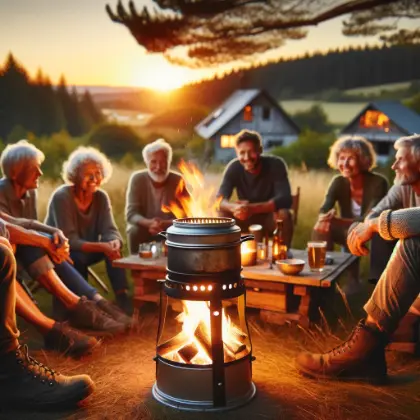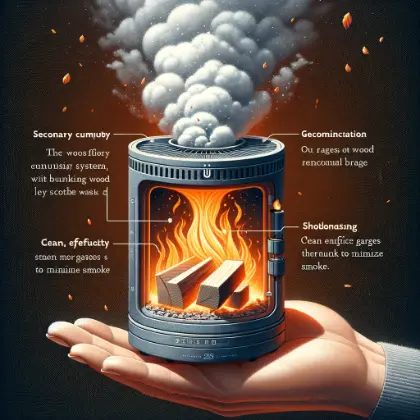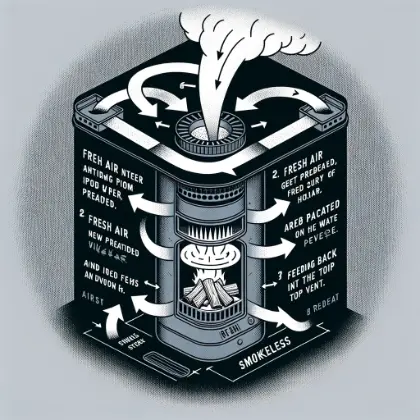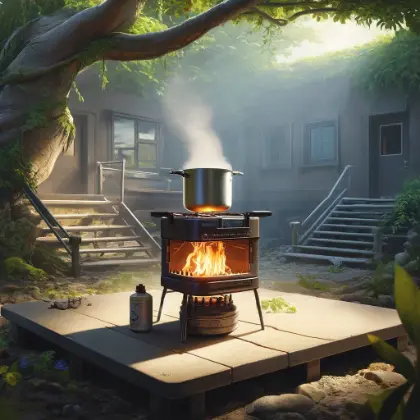How Does the Solo Stove Work? A Comprehensive Guide
Updated: 7 Jun 2024
789
Picture a lovely outdoor evening around a fire with your friends and family. There are no fumes to avoid, no excessive ash to clean up, just pure enjoyment of a clean and efficient fire. All this idyllic scenario is possible through the Solo Stove, a modern marvel in fire pit technology.
In this blog, we will look at how does the Solo Stove work. its innovative design, the technology behind the smokeless fire, and its benefits for outdoor enthusiasts.
How Does a Solo Stove Work? Unveil Innovative Technology
The principle of operation of the Solo Stove is quite simple yet innovative in the sense that it practices secondary combustion. This double-wall construction creates space for the stove to draw in cool air from the base, supporting the primary combustion process.

This cool air heats between the walls and rises to the top, where it again releases into the flames through tiny holes located around the inside rim of the stove. This way, gases burn off entirely before rising and escaping. This expelled air ignites again, providing a hotter, more efficient burn.
This secondary combustion process maximizes heat return and significantly reduces smoke and soot, making the Solo Stove a cleaner option than traditional campfires. That increased efficiency in burning also means that the stove consumes less fuel, therefore, longer burn times with less wood for users.
The other positive thing about the Solo Stove is that it is, in fact, very mobile and durable: made out of stainless steel, it can easily withstand inclement elements and is frequently used in backpacking, at a campsite, in the backyard, and in any survival situation.
The Solo Stove provides an excellent, green way to gather around a fire for camping, backyard living, or survival —consistent warmth and light.
Double-Wall Design

The very basis and creative design of the Solo Stove is in the double-walled construction itself. It creates a very robust airflow system that augments combustion efficiency. The double-wall design works based on the principle of air entering through the bottom vents and flowing into the walls of the stove.
As it rises, the air gets heated between the walls before it is finally expelled through the top vents, ensuring a continuous preheated supply of oxygen to the existing fire.
This way, it provides a hotter burn with minimum smoke. The double-wall construction increases the combustion efficiency and contributes to the strength of the stove to burn in a consistent, intense flame.
This is ideal and perfect for different kinds of outdoor activities. According to Natural Fire Pits, a double-wall stove allows you to cook good food.
Secondary Combustion
One of the distinguishing characteristics of the Solo Stove is the secondary combustion feature, which houses its very own system within the system called secondary combustion. This system is crucial to realizing a smokeless fire. When wood burns, it gives off volatile gases.

In a traditional firepit, these gases escape in the form of smoke. However, the Solo Stove design returns these gases to the fire as they pass over it. The gases burn entirely within the flame, creating a much cleaner burn with very little smoke.
Not only does it cause minimal impact on the environment, but the design is efficient and effective, assuring your Solo Stove is one of the best outdoor cookware heaters available today.
The efficient burn reduces smoke and produces little ash, and thus, the Solo Stove is easily cleanable and low maintenance. Learn more about the gas stove maintenance guide.
Air Flow System

The airflow system in the Solo Stove is ingeniously designed to optimize combustion efficiency. Fresh air is drawn into the stove through vents at the bottom. It then rises through the double walls of the stove as it gets preheated. On the top vents, the preheated air is fed back into the fire, enhancing a hotter and more efficient burn.
The complete flow of oxygen allows the fire to remain lively and smokeless, improving the overall user experience. The intelligent design that went into creating this airflow system guarantees every burn to be as efficient and smoke-free as possible.
What Fuel Does a Solo Stove Use?
The Solo Stove is designed to use a variety of natural biomass fuels. The most commonly recommended fuel is dry hardwoods such as oak, hickory, maple, and birch. In addition to that, these hardwoods burn longer and throw in more heat as compared to the softwoods, thus giving you a very efficient smokeless fire that Solo Stoves are known for.

Other possible kinds of dry biomass materials that can be used apart from the hardwoods include twigs, small branches, and pine cones, among others. It is, however, vital to ensure that these are dry since wet wood might yield more smoke and hinder the efficiency of combustion by the stove. Learn how to fix a smoking gas stove.
One feature of the Solo Stove design is that it is very versatile and can use any sort of fuel without compromising performance.
Tips for Setting Up Your Solo Stove For Efficient Working

Location
When using your Solo Stove, it is essential that you set it up right for safety and optimal performance. Ideally, the stove should be placed not less than 6 feet from buildings and such like structural members.
Also, locate it where overhanging branches and other blockades are not above the stove at a distance of 15-20 feet. This not only prevents potential fire but also provides the right setting for perfect airflow and combustion.
Proper placement is critical to ensure both adequate and safe functioning of the stove, which in turn provides users with the best possible experience .
Initial Setup
Assembling and getting your Solo Stove ready for its first use are relatively straightforward. Begin by placing it on a stable, heat-resistant surface. Drop the base plate and ash pan into the stove, then position the cooking ring. Ensure all the parts are secure before lighting a fire.
Following these steps, get your Solo Stove ready for a safe and efficient burn. Ensure it is put in place correctly to get the best performance out of the Solo Stove while savoring the great outdoor experience.
Best Practices For Optimal Solo Stove Working
For the best performance, use dry hardwoods like oak, hickory, or maple. These woods burn longer and produce more heat compared to softwoods. Avoid using wet or damp wood, as it can create excess smoke and hinder the combustion process.
Dry kindling and fire starters can help you ignite the fire quickly and efficiently. Using the right type of wood and ensuring it is dry is crucial for maintaining a smokeless and efficient fire .
Fire Starting Techniques
Starting a fire in the Solo Stove is simple. Begin by placing small, dry kindling in the center of the stove. Light the kindling with a match or lighter, then gradually add larger pieces of wood as the fire grows.
The key is to allow the fire to establish itself before adding too much wood. This method ensures a quick ignition and a steady, smokeless flame. Proper fire-starting techniques are essential to enjoy the full benefits of the Solo Stove’s design.
Maintaining the Fire
Maintaining an efficient, smokeless fire requires attention to the wood placement and airflow. Avoid overloading the stove with wood, as this can obstruct the airflow and cause smoke. Instead, add wood gradually, ensuring that the flames remain visible and the airflow unobstructed.
Regularly check the ash pan and remove excess ash to maintain optimal airflow and combustion efficiency. Consistent maintenance is key to ensuring the Solo Stove performs at its best, providing a clean and enjoyable fire every time (Hunting Waterfalls).
Conclusion
What sets the Solo Stove apart is the innovative design with a double-wall construction and secondary combustion system that makes fire smokeless and fuel-efficient. This stove works best with dry hardwood and other natural biomass fuels. Not only is it portable and tactically durable, but it is environment-friendly as well, endearing it to all those who love outdoor adventures.
Its versatility, ease of use, and high fuel efficiency make it a valuable addition to any outdoor activity, whether camping, hiking, or just enjoying a backyard gathering. The Solo Stove enhances the outdoor fire experience by providing warmth and enjoyment with minimal environmental impact.
Frequently Asked Questions About Solo Stove:
Can I Put Water in My Solo Stove?
You should not put water in your Solo Stove. This will likely lead to critical changes in temperature that can undermine the stainless steel structure and make an overly messy business out of it.
Can You Still Smell the Fire in a Solo Stove?
As much as the Solo Stove is smokeless, you will experience a slight smell from the burning wood. This is attributed to the fact that although the stove significantly decreases smoke, the aroma of the burning wood is not entirely extinguished.
How Long Will a Solo Stove Last?
A Solo Stove is designed to last several years courtesy of its sturdy stainless steel construction. Your Solo Stove will last for a long time with proper attention and cleaning, as well as secure storage.
Is Solo Stove Worth the Money?
This makes the Solo Stove efficient with excellent efficiency, smokeless operation, and durably built. The ease of mobility and ease of use endear this product to outdoorspeople the most. It is thus popular not only in camping but also in backyard functions and any other outdoor event or activity.
Can You Put Leaves in a Solo Stove?
While yes, leaves can be burned in a Solo Stove, fixin leaves should be dry hardwoods such as oak, hickory, or maple to get the most out of the stove. Burning leaves would likely produce more smoke and could clog the airflow system, reducing the efficiency of the furnace.
Is a Solo Stove Warm?
Yes, a Solo Stove is warm. The combustion process within the stove is efficient and, therefore, promises a solid and steady heat output. It could be the best outdoor heater that could keep you warm as you camp or even when relaxing in your backyard as you enjoy the bare views of the surroundings at night.
Can You Burn Anything in a Solo Stove?
Remember to burn in your Solo Stove only those recommended materials. Dry hardwoods make the best fires, but softwoods and leaves can be burned beyond that. Pressure-treated wood is off limits, as well as garbage and anything that can give off poisonous gases or too much smoke, for that matter. This way, you help ensure the Stove runs for years to come, and you have a safe experience with your beautiful fire.
Are Solo Stoves Safe?
Source Solo Stoves are made with a double-wall layer of material, which helps keep the outer surface quite cool and reduces burn risks. The Solo Stove is a fire pit, so it needs to be used responsibly: place it on a stable, heat-resistant surface and far from flammable materials; never leave a fire unattended—keep children and pets around the stove under supervision.
Please Write Your Comments